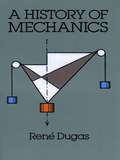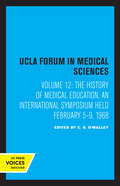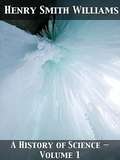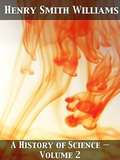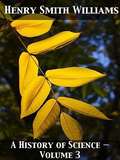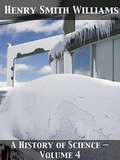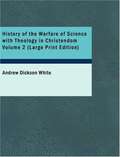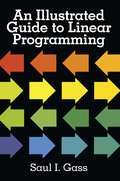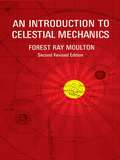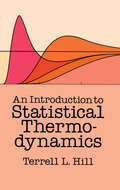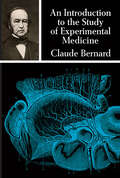- Table View
- List View
Getting a Feel for Lunar Craters
by David HurdThe text from a Braille, tactile book written for visually impaired people to feel what lunar craters are like.
A History of Mechanics
by René DugasIn this masterful synthesis and summation of the science of mechanics, Rene Dugas, a leading scholar and educator at the famed Ecole Polytechnique in Paris, deals with the evolution of the principles of general mechanics chronologically from their earliest roots in antiquity through the Middle Ages to the revolutionary developments in relativistic mechanics, wave and quantum mechanics of the early 20th century.The present volume is divided into five parts: The first treats of the pioneers in the study of mechanics, from its beginnings up to and including the sixteenth century; the second section discusses the formation of classical mechanics, including the tremendously creative and influential work of Galileo, Huygens and Newton. The third part is devoted to the eighteenth century, in which the organization of mechanics finds its climax in the achievements of Euler, d'Alembert and Lagrange. The fourth part is devoted to classical mechanics after Lagrange. In Part Five, the author undertakes the relativistic revolutions in quantum and wave mechanics.Writing with great clarity and sweep of vision, M. Dugas follows closely the ideas of the great innovators and the texts of their writings. The result is an exceptionally accurate and objective account, especially thorough in its accounts of mechanics in antiquity and the Middle Ages, and the important contributions of Jordanus of Nemore, Jean Buridan, Albert of Saxony, Nicole Oresme, Leonardo da Vinci, and many other key figures.Erudite, comprehensive, replete with penetrating insights, AHistory of Mechanics is an unusually skillful and wide-ranging study that belongs in the library of anyone interested in the history of science.
The History of Medical Education: An International Symposium Held February 5–9, 1968 (UCLA Forum in Medical Sciences #12)
by C. D. O’MalleyThis title is part of UC Press's Voices Revived program, which commemorates University of California Press’s mission to seek out and cultivate the brightest minds and give them voice, reach, and impact. Drawing on a backlist dating to 1893, Voices Revived makes high-quality, peer-reviewed scholarship accessible once again using print-on-demand technology. This title was originally published in 1970.
A History of Science -- Volume 1
by Edward Huntington Williams Henry Smith WilliamsShould the story that is about to be unfolded be found to lack interest, the writers must stand convicted of unpardonable lack of art. <P> <P> Nothing but dulness in the telling could mar the story, for in itself it is the record of the growth of those ideas that have made our race and its civilization what they are; of ideas instinct with human interest, vital with meaning for our race; fundamental in their influence on human development; part and parcel of the mechanism of human thought on the one hand, and of practical civilization on the other. Such a phrase as “fundamental principles” may seem at first thought a hard saying, but the idea it implies is less repellent than the phrase itself, for the fundamental principles in question are so closely linked with the present interests of every one of us that they lie within the grasp of every average man and woman— nay, of every well-developed boy and girl. These principles are not merely the stepping-stones to culture, the prerequisites of knowledge— they are, in themselves, an essential part of the knowledge of every cultivated person
A History of Science -- Volume 2
by Edward Huntington Williams Henry Smith WilliamsThe studies of the present book cover the progress of science from the close of the Roman period in the fifth century A. D. to about the middle of the eighteenth century. In tracing the course of events through so long a period, a difficulty becomes prominent which everywhere besets the historian in less degree— a difficulty due to the conflict between the strictly chronological and the topical method of treatment. <P> <P> We must hold as closely as possible to the actual sequence of events, since, as already pointed out, one discovery leads on to another. But, on the other hand, progressive steps are taken contemporaneously in the various fields of science, and if we were to attempt to introduce these in strict chronological order we should lose all sense of topical continuity.
A History of Science -- Volume 3
by Edward Huntington Williams Henry Smith WilliamsWith the present book we enter the field of the distinctively modern. There is no precise date at which we take up each of the successive stories, but the main sweep of development has to do in each case with the nineteenth century. <P> <P> We shall see at once that this is a time both of rapid progress and of great differentiation. We have heard almost nothing hitherto of such sciences as paleontology, geology, and meteorology, each of which now demands full attention. Meantime, astronomy and what the workers of the elder day called natural philosophy become wonderfully diversified and present numerous phases that would have been startling enough to the star-gazers and philosophers of the earlier epoch.
A History of Science -- Volume 4
by Edward Huntington Williams Henry Smith WilliamsAS regards chronology, the epoch covered in the present volume is identical with that viewed in the preceding one. But now as regards subject matter we pass on to those diverse phases of the physical world which are the field of the chemist, and to those yet more intricate processes which have to do with living organisms. <P> <P> So radical are the changes here that we seem to be entering new worlds; and yet, here as before, there are intimations of the new discoveries away back in the Greek days. The solution of the problem of respiration will remind us that Anaxagoras half guessed the secret; and in those diversified studies which tell us of the Daltonian atom in its wonderful transmutations, we shall be reminded again of the Clazomenian philosopher and his successor Democritus.
History of the Warfare of Science with Theology in Christendom
by Andrew Dickson WhiteWallpaper* City Guidesnot only suggest where to stay, what to eat, and what to drink, but what the tourist passionate about design might want to see, whether he or she has a week or just 24 hours in the city. <P> <P> Some of the highlights include up-and-coming neighborhoods, an `Architour? of landmark buildings, design centers, and the best shops to buy unique items. Wallpaper* City Guidespresent travelers with a fast-track ticket to the chosen location. The tightly-edited guides offer the best, most exciting, and the most beautiful of the featured city. The guides are expertly designed with function as a priority, and they have tabbed sections so that readers can find information easily. The guides include currency rate information, maps, and a color-coding system to help the reader navigate through different parts of the city. They are the ultimate combination of form and function. The guides are compiled byWallpaper*magazine experts and their extraordinary network of international correspondents. The writers have put their heads together to come up with fascinating, efficient guides for the hip, urban traveler with his or her finger on the pulse. They are truly the insider's guide to each featured city. The firstWallpaper* City Guideswere published in Fall 2006 on the occasion ofWallpaper*?sfirst anniversary. For more than a decade,Wallpaper*has been the first to uncover and enticingly present the best urban travel spots from across the globe. The City Guides are the perfect way to present a decade of experience in one precisely edited guide. As of early 2010, there are 80 city guides available, with seven more on the way by the end of the year.
The Human Essence: The Sources of Science and Art
by George ThomsonThis book is a short introduction to Marxism that addresses its political, historical and ideological aspects of science and art.
An Illustrated Guide to Linear Programming
by Dr Saul I. Gass"I would not hesitate to recommend the book." -- Industrial Engineering. Entertaining, nontechnical introduction covers basic concepts of linear programming and its relationship to operations research; geometric interpretation and problem solving, solution techniques, network problems, much more. Appendix offers precise statements of definitions, theorems, and techniques, additional computational procedures. Only high-school algebra needed. Bibliography.
Inorganic Chemistry for Geochemistry and Environmental Sciences: Fundamentals and Applications
by George W. Luther IIIInorganic Chemistry for Geochemistry and Environmental Sciences: Fundamentals and Applications discusses the structure, bonding and reactivity of molecules and solids of environmental interest, bringing the reactivity of non-metals and metals to inorganic chemists, geochemists and environmental chemists from diverse fields. Understanding the principles of inorganic chemistry including chemical bonding, frontier molecular orbital theory, electron transfer processes, formation of (nano) particles, transition metal-ligand complexes, metal catalysis and more are essential to describe earth processes over time scales ranging from 1 nanosec to 1 Gigayr. Throughout the book, fundamental chemical principles are illustrated with relevant examples from geochemistry, environmental and marine chemistry, allowing students to better understand environmental and geochemical processes at the molecular level. Topics covered include: * Thermodynamics and kinetics of redox reactions * Atomic structure* Symmetry* Covalent bonding, and bonding in solids and nanoparticles* Frontier Molecular Orbital Theory* Acids and bases* Basics of transition metal chemistry including * Chemical reactivity of materials of geochemical and environmental interest Supplementary material is provided online, including PowerPoint slides, problem sets and solutions. Inorganic Chemistry for Geochemistry and Environmental Sciences is a rapid assimilation textbook for those studying and working in areas of geochemistry, inorganic chemistry and environmental chemistry, wishing to enhance their understanding of environmental processes from the molecular level to the global level.
An Introduction to Celestial Mechanics (Dover Books on Astronomy)
by Forest Ray MoultonAn unrivaled text in the field of celestial mechanics, Moulton's theoretical work on the prediction and interpretation of celestial phenomena has not been superseded. By providing a general account of all parts of celestial mechanics without an over-full treatment of any single aspect, by stating all the problems in advance, and, where the transformations are long, giving an outline of the steps which must be made, and by noting all the places where assumptions have been introduced or unjustified methods employed, Moulton has insured that his work will be valuable to all who are interested in the subject.The text is divided into ten chapters which progress logically in terms of the difficulty of their subject matter. They are: Fundamental Principles and Definitions, Rectilinear Motion, Central Forces, The Potential and Attractions of Bodies, The Problem of Two Bodies, The Determination of Orbits, The General Integrals of the Problem of n Bodies, The Problem of Three Bodies, Perturbations - Geometrical Considerations, and Perturbations - Analytical Method. Important topics cove red include general equations, motion of falling particles, the heat of the sun, simultaneous differential equations, examples where J is a function of the coordinates alone, the universality of Newton's law, determination of the orbit from the law of force, attractions of simple solids, potential and attractions of simple bodies and ellipsoids, Ivory's method and level surfaces, elements of orbits, expansions and positions in orbits, transformations of coordinates, the Laplacian and Gaussian methods of determining orbits, motion of center of mass and area integrals, motion of the infinitesimal body, surfaces of zero relative velocity, effects of the components of the disturbing force, lunar theory, method of computing perturbations, and the perturbative function.Each chapter is followed by a historical sketch and bibliography pertaining to that subject. Over 200 problems appear at key points in the text, many of them answered.
Introduction to Climate Dynamics and Climate Modeling
by H. Goosse P. Y. Barriat W. Lefebyre M. F. Loutre V. ZanzA textbook about climate dynamics and climate modeling.
An Introduction to Statistical Thermodynamics (Dover Books On Physics Series)
by Terrell L. HillAlthough written on an introductory level, this wide-ranging text provides extensive coverage of topics of current interest in equilibrium statistical mechanics. Indeed, certain traditional topics are given somewhat condensed treatment to allow room for a survey of more recent advances.The book is divided into four major sections. Part I deals with the principles of quantum statistical mechanics and includes discussions of energy levels, states and eigenfunctions, degeneracy and other topics. Part II examines systems composed of independent molecules or of other independent subsystems. Topics range from ideal monatomic gas and monatomic crystals to polyatomic gas and configuration of polymer molecules and rubber elasticity. An examination of systems of interacting molecules comprises the nine chapters in Part Ill, reviewing such subjects as lattice statistics, imperfect gases and dilute liquid solutions. Part IV covers quantum statistics and includes sections on Fermi-Dirac and Bose-Einstein statistics, photon gas and free-volume theories of quantum liquids.Each chapter includes problems varying in difficulty — ranging from simple numerical exercises to small-scale "research" propositions. In addition, supplementary reading lists for each chapter invite students to pursue the subject at a more advanced level. Readers are assumed to have studied thermodynamics, calculus, elementary differential equations and elementary quantum mechanics.Because of the flexibility of the chapter arrangements, this book especially lends itself to use in a one-or two-semester graduate course in chemistry, a one-semester senior or graduate course in physics or an introductory course in statistical mechanics.
An Introduction to the Study of Experimental Medicine
by Claude BernardClear and penetrating presentation of the basic principles of scientific research from the great French physiologist whose contributions in the 19th century included the discovery of vasomotor nerves; nature of curare and other poisons in human body; functions of pancreatic juice in digestion; elucidation of glycogenic function of the liver.
Introductory Chemistry
by David W. BallDavid W. Ball of Cleveland State University brings his new survey of general chemistry text, Introductory Chemistry, to the market with a fresh theme that will be sure to hold student interest: "Chemistry is Everywhere." Introductory Chemistry is intended for a one-semester introductory or preparatory chemistry course.
Introductory Statistics
by Douglas S. Shafer Zhiyi ZhangIn many introductory level courses today, teachers are challenged with the task of fitting in all of the core concepts of the course in a limited period of time. The Introductory Statistics teacher is no stranger to this challenge. To add to the difficulty, many textbooks contain an overabundance of material, which not only results in the need for further streamlining, but also in intimidated students. Shafer and Zhang wrote Introductory Statistics by using their vast teaching experience to present a complete look at introductory statistics topics while keeping in mind a realistic expectation with respect to course duration and students' maturity level. Over time the core content of this course has developed into a well-defined body of material that is substantial for a one-semester course. Shafer and Zhang believe that the students in this course are best served by a focus on that core material and not by an exposure to a plethora of peripheral topics. Therefore in writing Introduction to Statistics they have sought to present only the core concepts and use a wide-ranging set of exercises for each concept to drive comprehension. As a result Introduction to Statistics is a smaller and less intimidating textbook that trades some extended and unnecessary topics for a better-focused presentation of the central material.

